Latest Posts
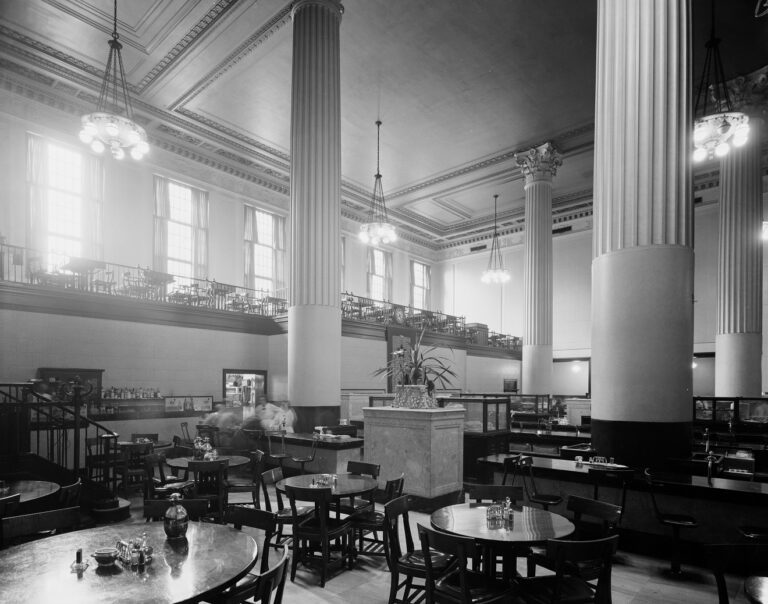
Fred Harvey lunchroom and restaurant at Union Station, Chicago, June 29, 1943. HB-07469-B, CHM, Hedrich-Blessing Collection.
When traveling by train was common practice, stopping at a Fred Harvey-owned establishment was almost a guarantee.
In 1876, a young English immigrant named Fred Harvey opened a small restaurant at a train depot in Topeka, Kansas. It was the start of what became an empire of hotels, shops, and eating establishments extending from the Great Lakes to the Pacific coast. By the 1880s, Harvey was operating seventeen restaurants along the Atchison, Topeka and Santa Fe Railway’s main line to which he added fifteen Harvey House restaurants by 1891. Harvey’s success was the result of his belief in giving delicious food with excellent service with linen and silverware at reasonable prices.
In Chicago, Harvey Co. establishments operated at both the Dearborn Station and Union Station. The company had eateries in Union Station from the beginning when the building opened in 1925, including the lunchroom and club-like dining room (top image), the cafeteria, Shoppers Mart soda fountain, and Iron Horse cocktail lounge. The menu shown above is for the Semaphore Luncheonette in 1941. All the items could be prepared or served quickly, making them ideal for travelers on a tight schedule. The Harvey Co. expanded into non-railroad restaurants, and Chicago had the Kungsholm Restaurant, Harvey House Restaurant, and Harlequin Restaurant, among others.
Fred Harvey died in 1901, and his sons operated the company through the 1930s. As air and car travel increased, business at railroad-based eateries declined. World War II provided a temporary boost with the Harvey Co. making meals for troop trains, but by the 1950s, railroad companies were consolidating service and closing depots. The Harvey Co. shifted its food service and hotel business to US national parks and was purchased by Amfac Corp. in 1968. In 2019, Amtrak announced plans to renovate the former Fred Harvey restaurant at Union Station and transform it into a dining and retail complex.
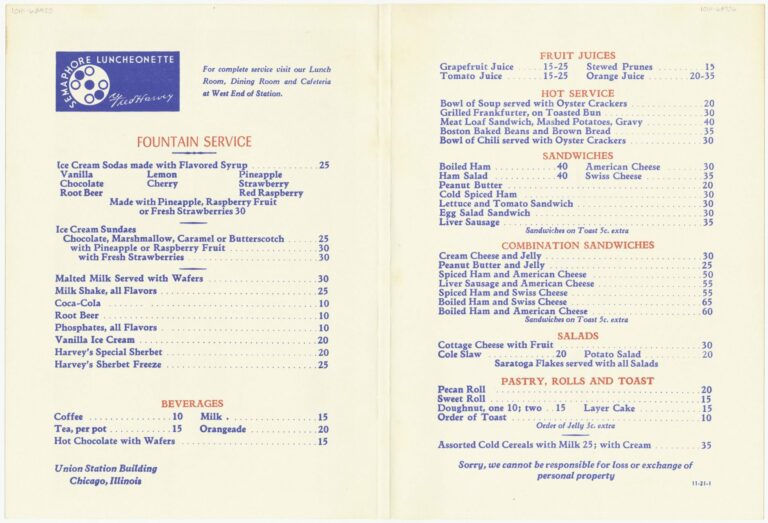
Inside front cover of 75th Anniversary Semaphore Luncheonette restaurant menu, Chicago, 1941. CHM, ICHi-068925, ICHi-068926.
Trace the city’s evolution from meatpacking capital to foodie paradise through our Google Arts & Culture exhibit Touring Chicago’s Culinary History, which features menus from the CHM Research Center.
Michael A. Bilandic became mayor after the death of Richard J. Daley in 1976. During his 1979 election campaign, Bilandic emphasized his ethnic and family loyalties with this brochure that included various recipes from his wife, Heather Bilandic, including such as her Potato/Leek Soup. Bilandic was soundly defeated by Jane Byrne during the Democratic primary.
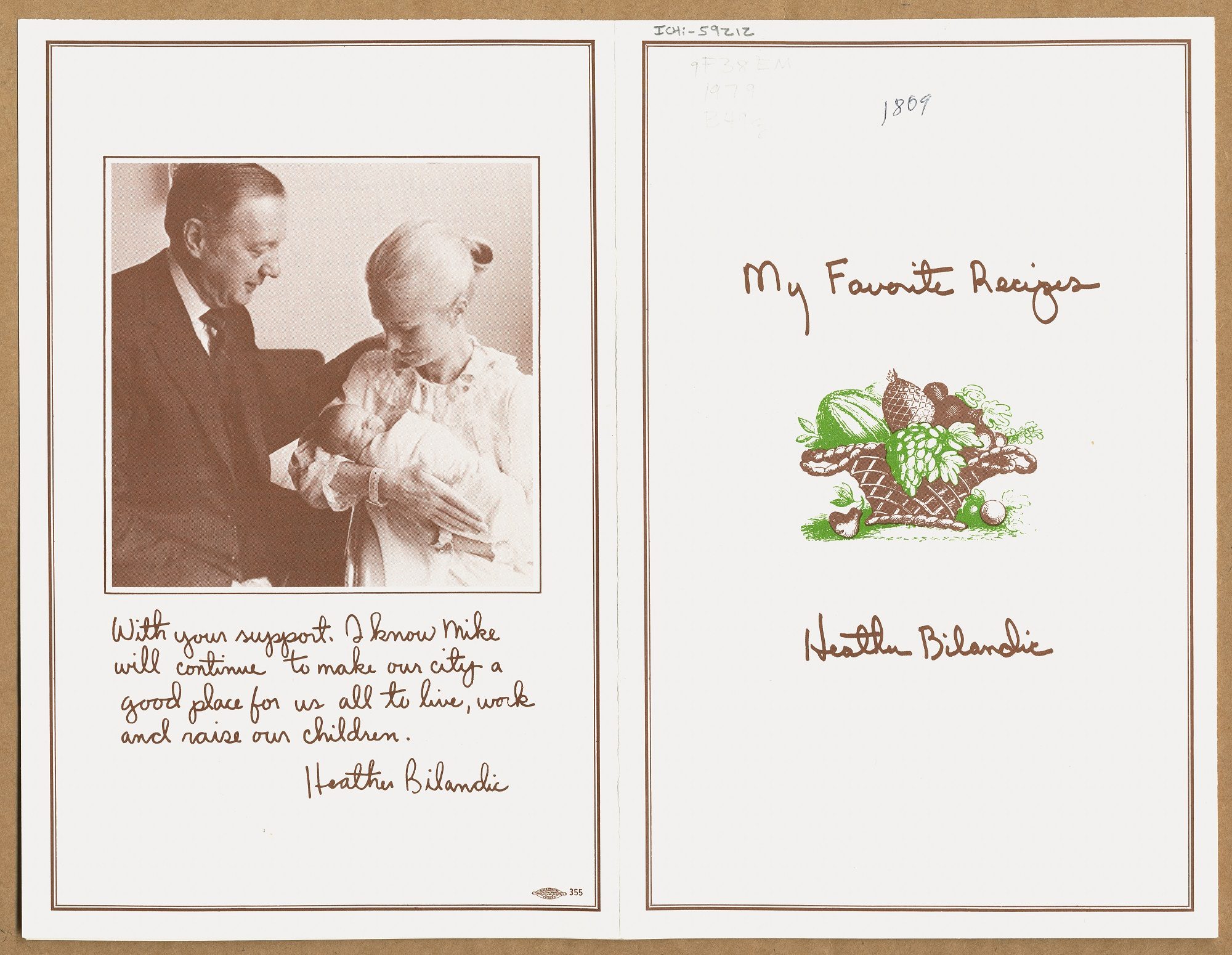
Michael A. Bilandic campaign literature and recipe booklet, 1979. CHM, ICHi-059212
Message on left:
With your support, I know Mike
will continue to make our city a
good place for us all to live, work
and raise our children.
Heather Bilandic
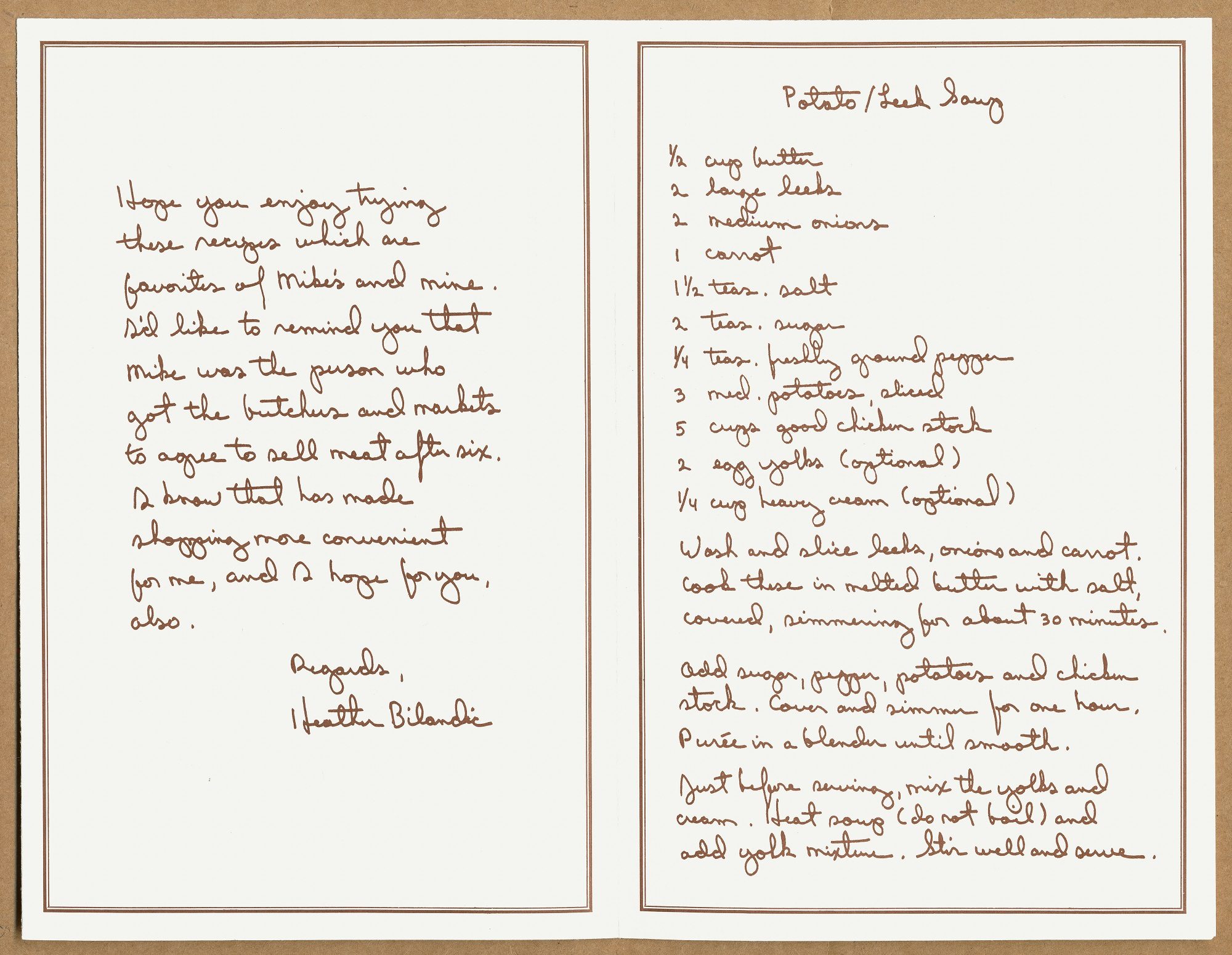
Message on left:
Hope you enjoy trying
these recipes which are
favorites of Mike’s and mine.
I’d like to remind you that
Mike was the person who
got the butchers and markets
to agree to sell meat after six.
I know that has made
shopping more convenient
for me, and I hope for you,
also.
Regards,
Heather Bilandic
Recipe on right:
Potato/Leek Soup
½ cup butter
2 large leeks
2 medium onions
1 carrot
1½ teas. salt
2 teas. sugar
¼ teas. freshly ground pepper
3 med. potatoes, sliced
5 cups good chicken stock
2 egg yolks (optional)
¼ cup heavy cream (optional)
Wash and slice leeks, onions and carrot. Cook these in melted butter with salt, covered, simmering for about 30 minutes.
Add sugar, pepper, potatoes and chicken stock. Cover and simmer for one hour. Purée in a blender until smooth.
Just before serving, mix the yolks and cream. Heat soup (do not boil) and add yolk mixture. Stir well and serve.
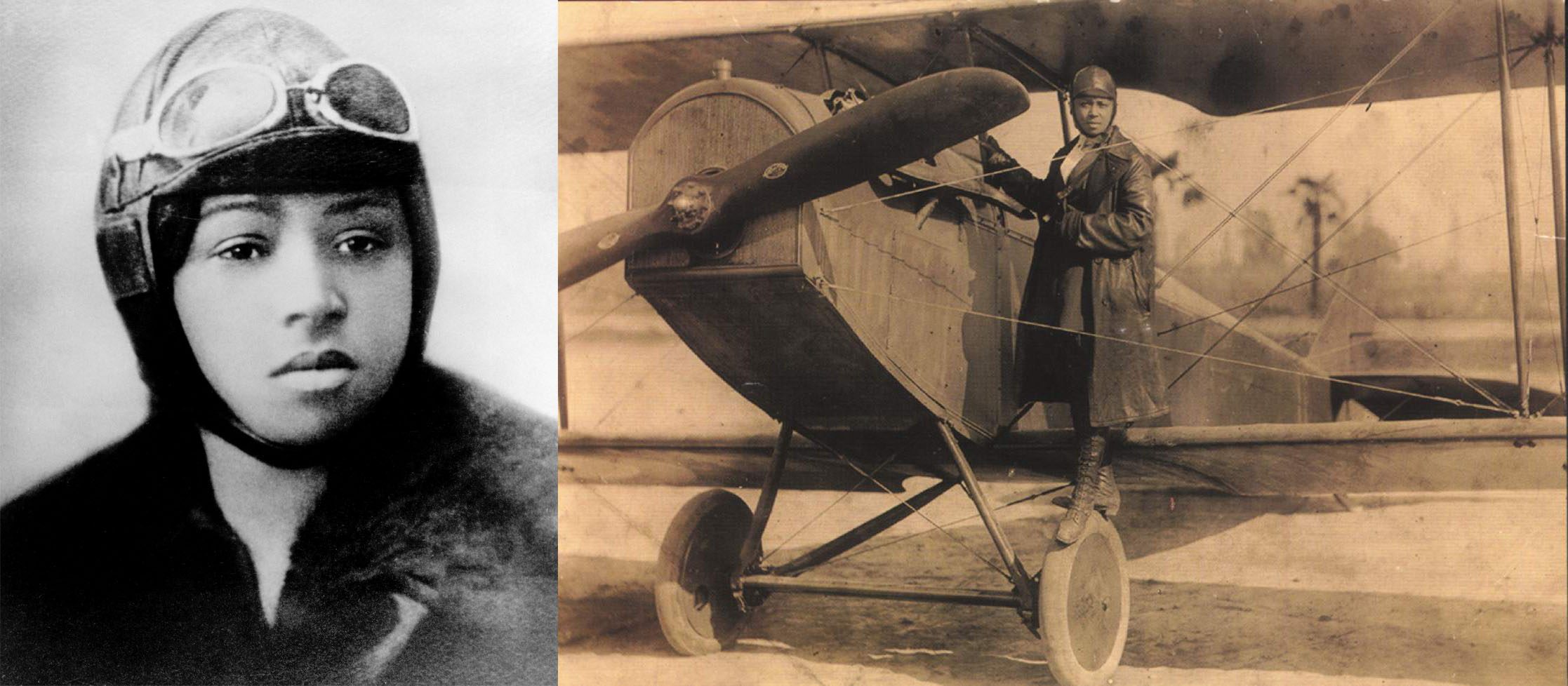
From left: Portrait of Bessie Coleman, pilot, c. 1921. CHM, ICHi-026774. Bessie Coleman on the wheel of a Curtiss JN-4 “Jennie” in her custom-designed flying suit, c. 1924. NASM 92-13721, Smithsonian Institution.
On January 26, 1892, Bessie Coleman was born in Atlanta, Texas. She was the first Black woman in the world to earn an aviator’s license.
A daughter of George and Susan Coleman, Bessie Coleman was one of thirteen children. During her youth, a number of aviation milestones may have influenced her: in 1903, the Wright brothers made the first controlled, sustained flight of a powered heavier-than-air aircraft; in 1910, Baroness Raymonde de la Roche became the first woman to earn a pilot’s license; in 1911, Harriet Quimby became the first American woman to earn a pilot’s license; and in 1917, Eugene Jacques Bullard became the first African American military pilot to fly in combat, and the only African American pilot in World War I, albeit for France.
Like many other African Americans in the early twentieth century, Coleman decided to seek better opportunities in the North. She moved to Chicago in 1915 and lived with two of her brothers on the South Side. Both of them had fought overseas during World War I and most likely encouraged her dream of becoming a pilot. However, she faced prejudice both as a woman and an African American and found herself unable to train in the United States.
With the encouragement of Robert S. Abbott, publisher of the Chicago Defender, Coleman learned French and saved up money from her work, first as a manicurist and then a manager of a chili parlor. In November 1920, she gained entrance into the Caudron School of Aviation in Le Crotoy, France. On June 15, 1921, Coleman obtained her pilot’s license from the Fédération Aéronautique Internationale, and after some additional training in Paris, she returned to the United States in September 1921.
Upon her return, Coleman became a barnstormer with the Chicago Defender as her sponsor and toured the United States. On October 15, 1922, more than 2,000 people came to the Checkerboard Field in west suburban Maywood (now Miller Meadow Forest Preserve) for her first exhibition in Chicago. Coleman died in a plane crash in Florida in 1926.
Inspired by Bessie Coleman, a group of African American pilots organized the Challenger Air Pilots Association in 1931. The organization founded an airport in south suburban Robbins in 1933 to accommodate the needs of African American pilots who faced discrimination at other Chicago airports.
Learn more about Chicago’s airports in our Encyclopedia of Chicago entry.
Studs Terkel Radio Archive
Studs Terkel talked to the twentieth century’s most fascinating people in his forty-five years on WFMT radio, from notable experts and award-winning performers to ordinary folks and everyday citizens. In 1981, he spoke with air traffic controller Jim Paulei about what a day on the job looks like and the Professional Air Traffic Controllers Organization (PATCO) strike.
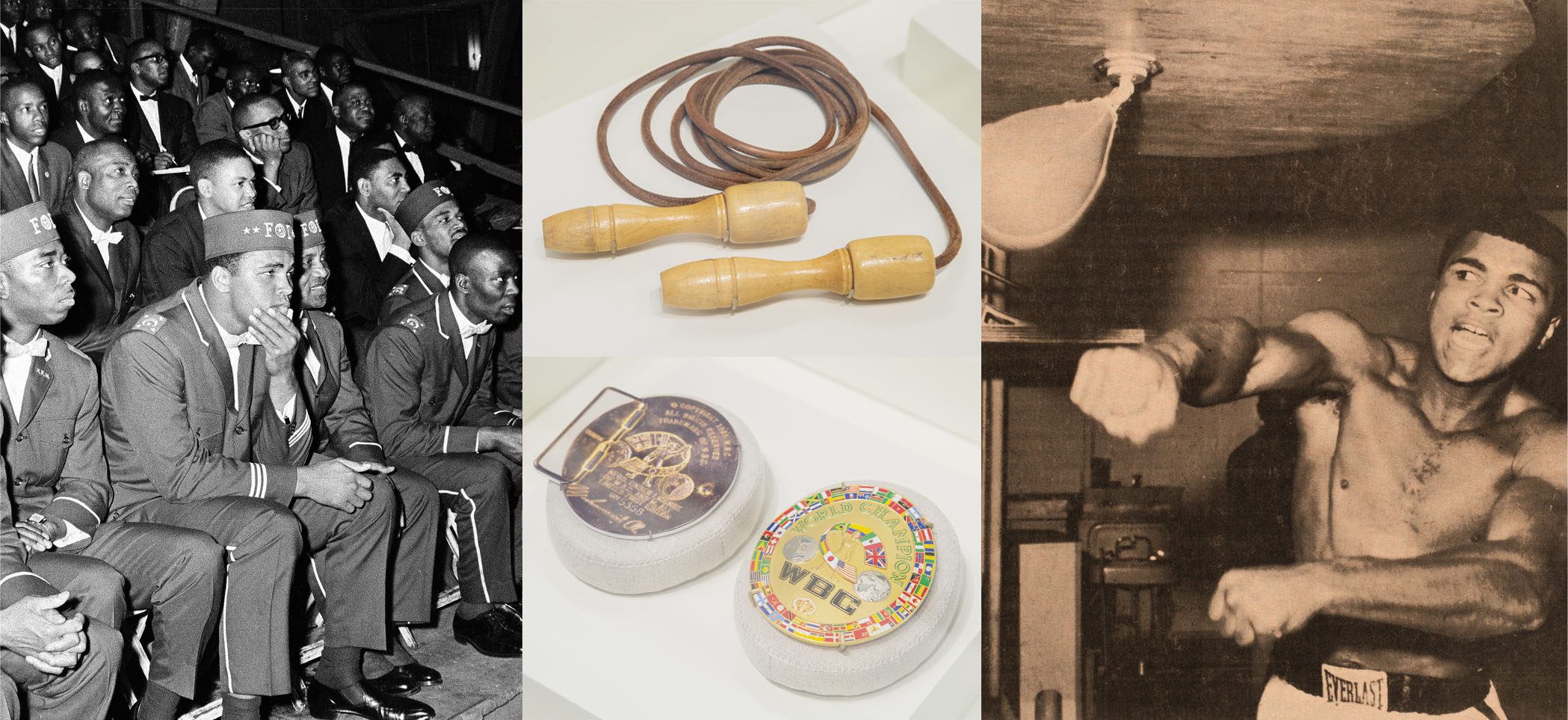
On this day in 1942, Muhammad Ali (né Cassius Marcellus Clay Jr.) was born in Louisville, Kentucky. He began boxing at twelve years old and rose quickly to national prominence, becoming an amateur boxing champion by the time he graduated high school. Ali gained valuable experience in the late 1950s—in 1958, he competed in the Golden Gloves tournament at Chicago Stadium and narrowly missed attending the 1959 Pan Am Games in Chicago, losing in the trials to Amos Johnson, who eventually won gold there. By the next summer, Ali qualified for the 1960 Olympics in Rome, where he won the light heavyweight gold medal, catapulting him to international fame and the start of his professional career.
In 1962, Muhammad Ali attended a Nation of Islam Saviours’ Day event where the opening speaker was Malcolm X, a charismatic Nation of Islam (NOI) minister who spent the previous decade attracting new converts and establishing new temples around the US. The NOI was founded in Detroit in 1930 and moved to Chicago in the mid-1930s, where its headquarters has remained since. By 1964, Ali became a member of the NOI, shed his birth name of Cassius Clay Jr., and moved to Chicago’s South Side, where he lived for about twelve years to further his studies.
While living in Chicago, Ali continued his boxing training. He used this jump rope, which he gifted to Sultan Muhammad, the son of his personal manager, Jabir-Herbert Muhammad. Sultan Muhammad served as the personal pilot and aide to NOI leader Elijah Muhammad, his grandfather. In 1985, Jabir-Herbert Muhammad received this limited-edition, gold-plated World Boxing Council belt buckle to mark Muhammad Ali’s reign as the greatest boxer of all time. The back bears Ali’s facsimile signature and the edition number 5,358. Both of these objects were loaned to the Chicago History Museum for our exhibition American Medina: Stories of Muslim Chicago.
Listen to Muhammad Ali discuss his childhood and family, conversion to Islam, stance on the Vietnam War, and experiences in jail in his oral history interview with Studs Terkel.
From left: Muhammad Ali (hand on chin) wears a Fruit of Islam uniform as he listens to the leader of the Nation of Islam, Elijah Muhammad, speak to a crowd at the Saviours’ Day event in the Coliseum at 15th St. and Wabash Ave., Chicago, February 27, 1966. ST-19031786-0007, Chicago Sun-Times collection, CHM. Jump rope with autographed handle, United States, c. 1970. Commemorative World Boxing Council belt buckle, 1985. Both items courtesy of Sultan Rahman Muhammad. Muhammad Ali training in Chicago, published on page 9 of Muhammad Speaks, November 10, 1967. CHM, ICHi-177193A.
Studs Terkel Radio Archive
In his forty-five years on WFMT radio, Studs Terkel talked to the twentieth century’s most fascinating people. Browse our growing archive of more than 1,200 programs. Explore the archive.
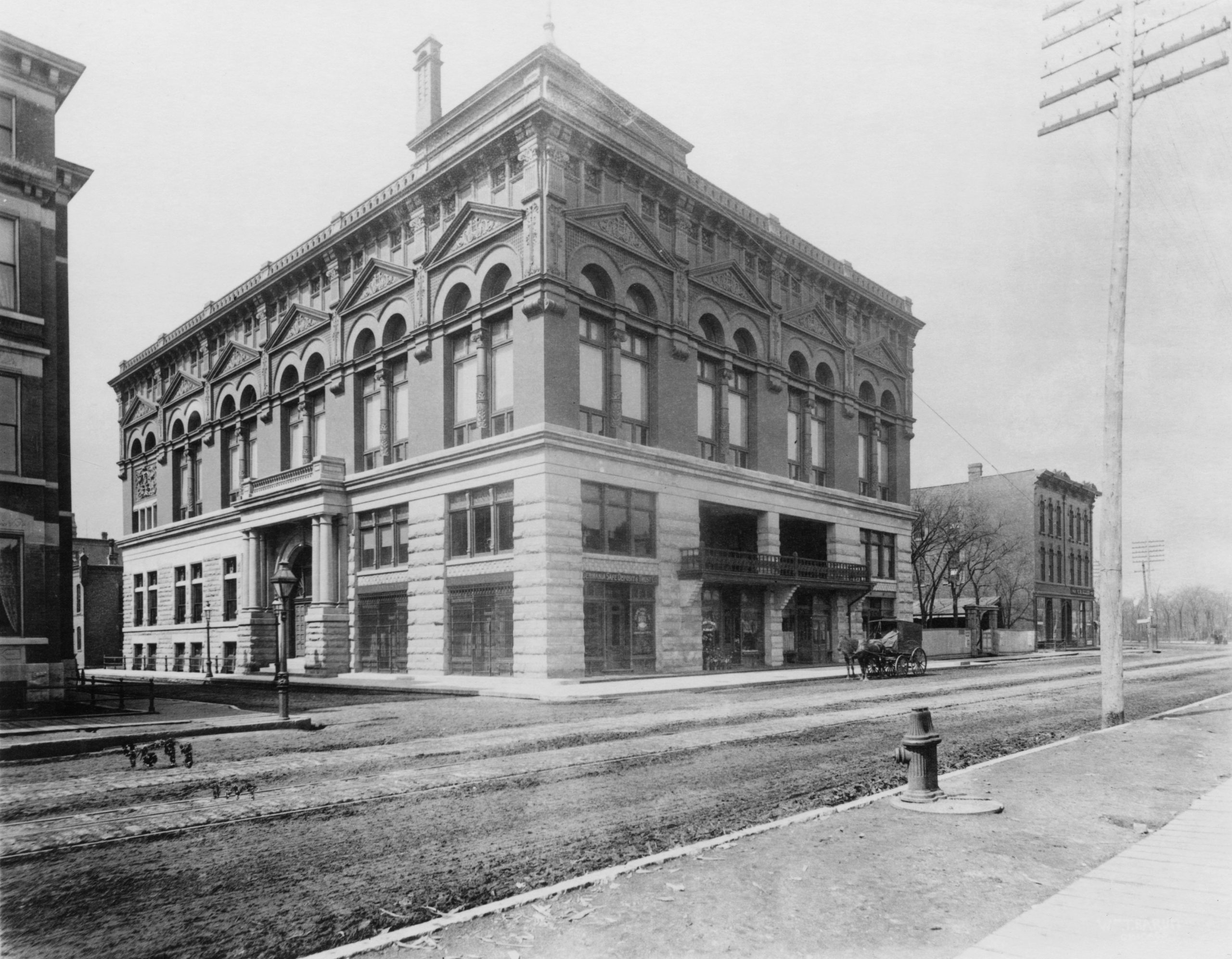
An undated photograph of the Germania Club at Clark Street and Germania Place, Chicago. CHM, ICHi-015118; W. T. Barnum, photographer
On January 13, 2011, the Germania Club Building in the city’s Old Town neighborhood was designated a Chicago Landmark. The history of this neighborhood club can be traced back to the Germania Männerchor, a men’s chorus comprising German American Civil War veterans who sang at President Abraham Lincoln’s funeral ceremonies in Chicago in 1865.
Chicago’s first substantial German community took shape in the 1850s when immigrants from Bavaria and Württemberg settled around what is now the Near North Side. Traces of that early group can still be found in that area, such as the Glunz Tavern (1888) and St. Michael’s parish, which was established in 1852 to serve a German Catholic congregation. Choirs thrived within the German immigrant community, as they were a vital social network and helped preserve ethnic identity. The Männergesangverein (1852) was among Chicago’s earliest ethnic choral societies, followed by the Germania Männerchor (1865) and the Concordia, an offshoot that split from Germania in 1866.
The Germania Männerchor became known as the Germania Club shortly after its founding and had the distinction of being the city’s oldest German American organization. When their building was completed in 1889, it served as a focal point for Chicago’s German American community through much of the twentieth century. It was designed by W. August Fiedler, a German immigrant and club member who was a partner at the architectural firm Addison & Fiedler. With its round-arched window openings and thick-masonry walls, the Germania Club Building’s design combines stylistic features of the Romanesque Revival style, as well as the neoclassical style, as seen in its pedimented windows, projecting cornice, and columned entrance portico. Inside, the building features grand historic spaces, including a ballroom with thirty-five-foot-tall walls and a large dining room. The Germania Club Building was added to the National Register of Historic Places in 1976.
The club was briefly called the Lincoln Club during World War I when anti-German sentiment was strong in the United States, but reverted to its original name in 1921. Amidst an evolving neighborhood and increased options for socializing, the Germania Club dwindled in numbers until it was disbanded in 1986. The Germania Club records, which are now housed in CHM’s Abakanowicz Research Center, includes sheet music and account ledgers.
Learn more about the history of Chicago’s German community in our Encyclopedia of Chicago entry.
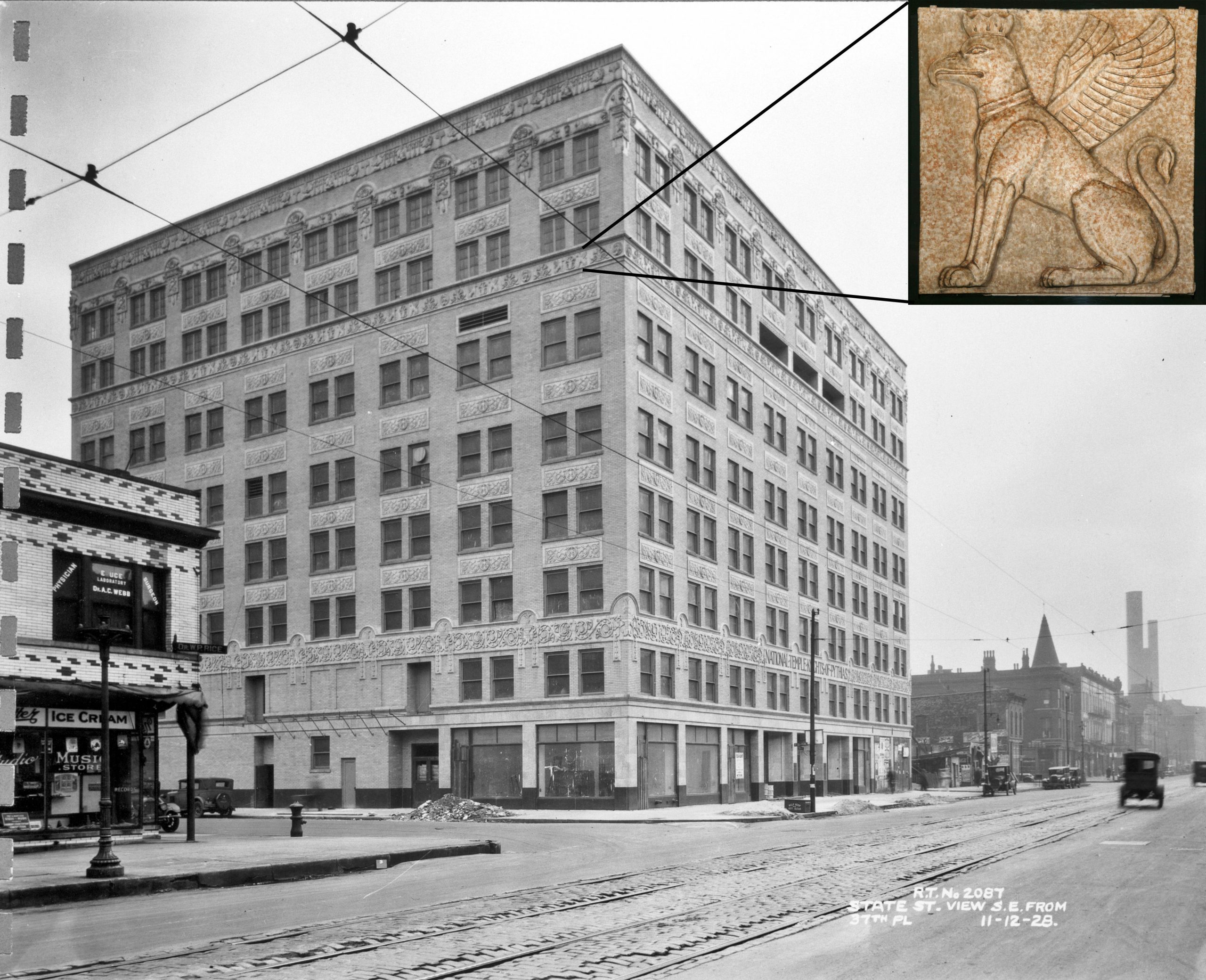
The Knights of Pythias Temple at 3737 S. State St., Chicago, 1928. CHM, ICHi-019351. A terra-cotta tile depicting a griffin from the Knight of Pythias Temple in Chicago, 1927. CHM, ICHi-066658.
On this day in 1882, Walter T. Bailey was born in Kewanee, Illinois, to Emanuel and Lucy Bailey. He was the first African American to graduate with a BS in architectural engineering from the University of Illinois at Urbana-Champaign, the first licensed African American architect in the state of Illinois, and the first licensed African American architect in Chicago.
Upon his graduation from the University of Illinois in 1904, Bailey worked in firms in Kewanee and Champaign. In 1905, he was appointed head of the Mechanical Industries Department at Tuskegee Institute in Alabama, where he also supervised planning, design, and construction of several campus buildings. Bailey left Tuskegee in 1916 to open his own office in Memphis, where he made business contacts with the Knights of Pythias, a fraternal organization that was integrated at its founding in 1864, became segregated beginning in 1880, and didn’t reintegrate until 1990 because both Black and white branches were secret societies and each branch had lost track of the other. Bailey soon received the biggest commission of his career—the Knights of Pythias’ new national headquarters in Chicago—and planning began in 1922. By 1924, he moved his practice to Chicago to supervise the project.
From the start, the National Pythian Temple was designed to impress. The eight-story Egyptian Revival building featured terra-cotta planters and detailing on its exterior, as well as a 1,500-seat theater and rooftop garden, all in the heart of the bustling Bronzeville neighborhood at State and 37th Streets. Completed in 1928, it was deemed the world’s largest, most expensive building ever built and designed by Black people. The Knights of Pythias eventually lost ownership of the building, and it was reconfigured into multiunit housing as part of a project with the Works Progress Administration, the federal employment program that President Franklin Roosevelt established in 1935. The building was abandoned by the 1970s and demolished in 1980. It is still considered one of the major African American architectural projects of the early twentieth century.
Despite this large commission early in his career, Bailey was not able to sustain his success—his subsequent work consisted of smaller projects such as churches and renovations. When the Great Depression began, Chicago’s Black business community saw widespread financial ruin, further reducing the possibility of new construction. Bailey’s final large project was the First Church of Deliverance (1939), and at the time of his death on February 21, 1941, he was working on the interior remodeling of Olivet Baptist Church.
See more images from our collection of architectural photography.
CHM Images
Peruse a selection of digitized prints and photographs at CHM Images, our online portal. Featured galleries include images from our recently acquired Chicago Sun-Times Photography Collection, Raeburn Flerlage’s work documenting the Chicago blues and folk music scene during the 1950s–1970s, and Declan Haun’s photography capturing the American Civil Rights Era.
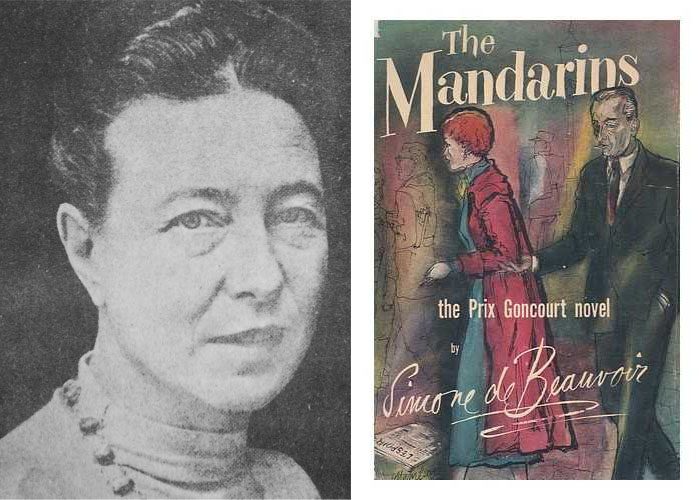
From left: Simone de Beauvoir, c. 1968. Wikimedia Commons; The Mandarins, 1st English-language edition, World Publishing Company, 1956; cover art by Laszlo Matulay
On this day in 1908, French writer and philosopher Simone de Beauvoir was born in Paris. She was a prolific and sometimes controversial writer who is perhaps best known for her seminal feminist text, The Second Sex (1949). While she was based mostly in Paris, Beauvoir traveled extensively and also spent time in Chicago. During a visit in 1947, she met writer Nelson Algren at the Palmer House hotel, which was the start of a brief but impactful romantic relationship between the two. A fictionalized account of their relationship is depicted in Beauvoir’s award-winning novel, The Mandarins (1954), which she dedicated to Algren.
The Mandarins covers the lives of a group of French intellectuals at the end of World War II through the mid-1950s based on Beauvoir’s experience, through the character Anne, navigating life, personal morality, and the political landscape after living through the Nazi occupation of Paris. Though she denied that the novel was a “roman à clef,” Beauvoir did say in her memoirs that the character of Lewis Brogan was based on Algren.
The novel covers Anne’s first meeting with Lewis in Chicago, where he takes her out to dinner at a pizzeria, to a burlesque show, and to listen to jazz at a dance hall. She claims that Lewis “knew everyone” and that it was the best evening she had spent in America. The experience mirrors the first meeting of Algren and Beauvoir, and the novel follows some of their subsequent travels together. Though their affair ended with some bitterness on Algren’s end, Beauvoir was buried with a silver ring on her finger that was a gift from Algren.
During Beauvoir’s relationship with Algren, he introduced her to his friend Studs Terkel, who in 1960 interviewed her about her upbringing and influences as an existentialist writer.
Studs Terkel Radio Archive
In his forty-five years on WFMT radio, Studs Terkel talked to the twentieth century’s most fascinating people. His radio program, with its deeply rooted humanistic approach to the big questions of human life and social organization, was filled with philosophical inquiry and search for deeper meaning. That said, Terkel did not interview a large number of actual philosophers about specifically “philosophical” books or debates. Instead, listeners will find remarkably similar approaches to the pursuit for metaphysical, ethical, or aesthetic understanding, whether the conversation is with a celebrated philosopher like Bertrand Russell or a group of teenagers living on the West Side of Chicago.
On December 16, 2020, Major League Baseball (MLB) Commissioner Rob Manfred made big sports news with the announcement that the MLB had “elevated” seven professional Negro Leagues to major league status. “All of us who love baseball have long known that the Negro Leagues produced many of our game’s best players, innovations, and triumphs against a backdrop of injustice,” Manfred declared in a statement. “We are now grateful to count the players of the Negro Leagues where they belong: as Major Leaguers within the official historical record.” This elevation includes leagues that played from 1920 through 1948 and consists of roughly 3,400 players, thirty-five of whom are Hall of Famers.
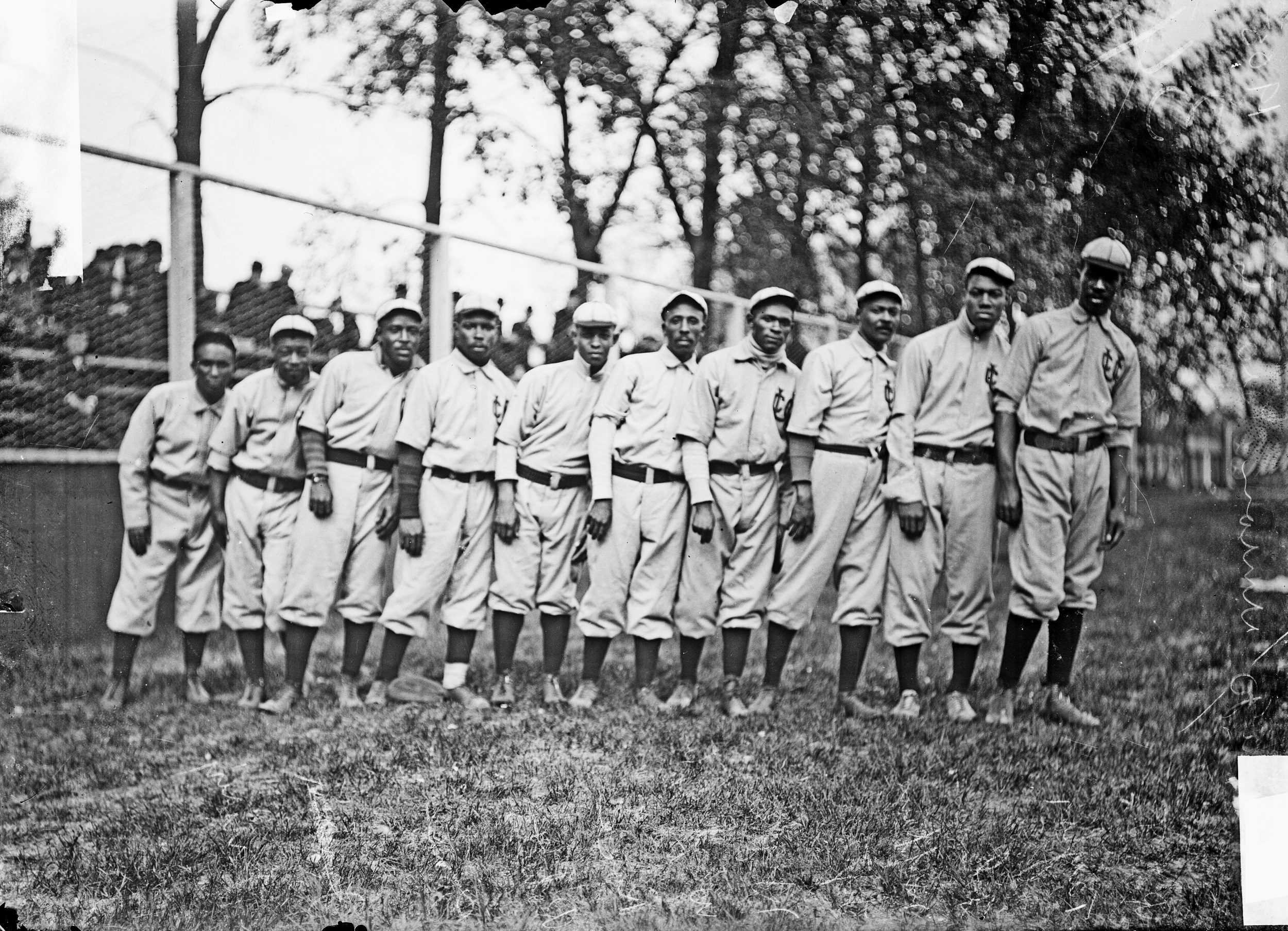
The Chicago American Giants baseball team on the field at a ballpark, Chicago, 1911. SDN-009529, Chicago Daily News collection, CHM
Chicago, of course, stands tall in the history of African American baseball and the Negro Leagues. The Chicago American Giants, led by Andrew “Rube” Foster, became a charter franchise in the Negro National League (NNL) in 1920 with Foster as the NNL’s driving force. Before managing the American Giants and serving as the NNL’s president and treasurer, Foster pitched in various Negro Leagues. In 1902, he won forty-four games in a row as the Philadelphia Cuban X-Giants’ star hurler.
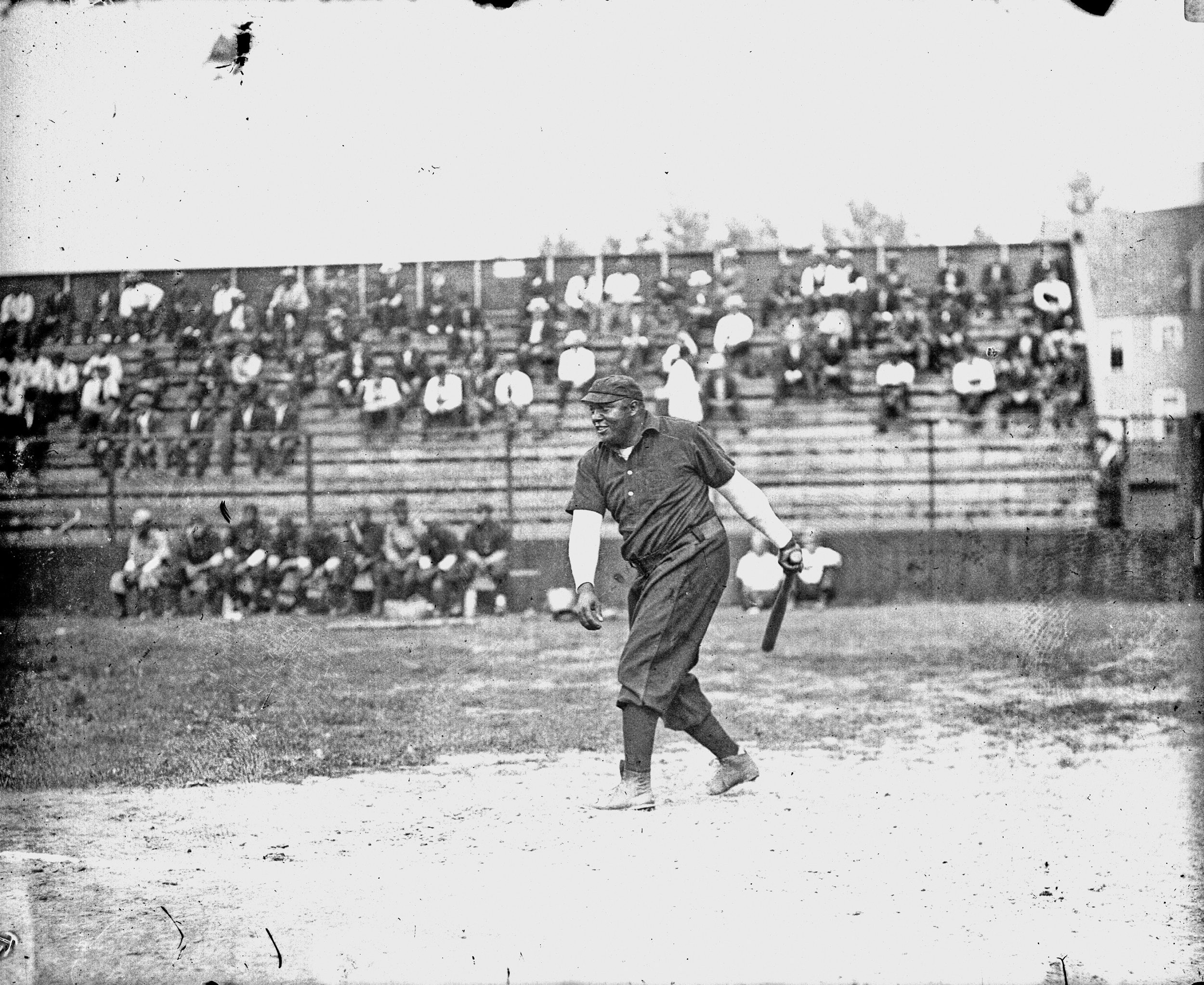
Rube Foster of the Leland Giants follows through after swinging a bat, Chicago, 1909. SDN-055361, Chicago Daily News collection, CHM
Foster’s American Giants won three NNL titles in 1920, ’21, and ’22. He amassed an amazing .635 winning percentage over sixteen seasons as the American Giants’ skipper. Longtime American Giants third baseman and eventual manager Dave Malarcher praised Foster’s coaching skills, calling him “an absolute genius in handling men, in devising strategies of defense and attack.” The American Giants played at South Side Park, which was just a few blocks away from today’s Guaranteed Rate Field where the Chicago White Sox play.
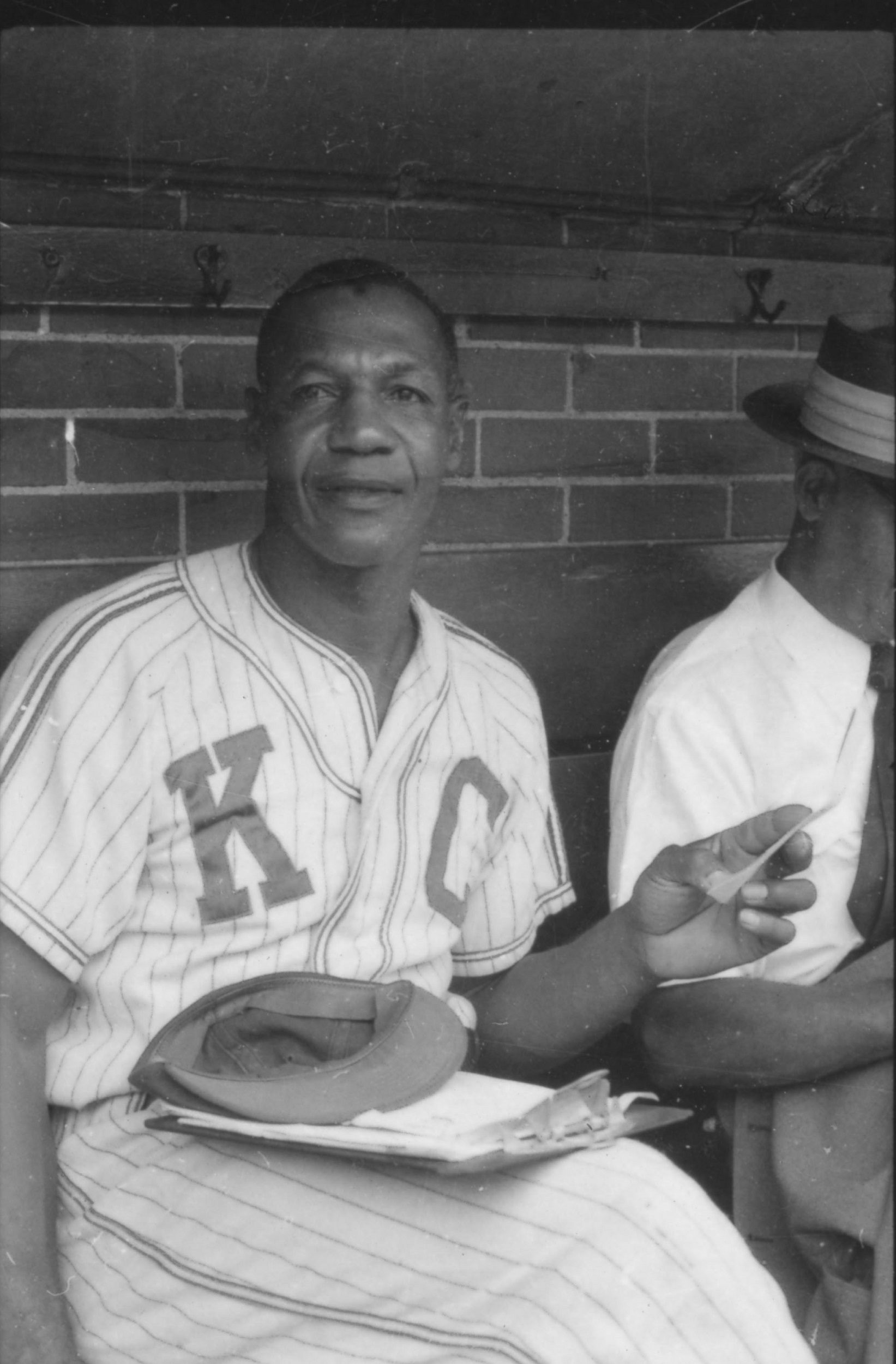
Buck O’Neil of the Kansas City Monarchs in the visitors’ dugout, Chicago, August 2, 1955. CHM, ICHi-052256-A; photograph by Arthur Siegel
In their humble wooden ballyard, also known as Schorling Park, the American Giants regularly drew crowds that outnumbered those of the White Sox and Cubs of the all-white Major Leagues. The American Giants sometimes played and typically beat Major League clubs and Major League all-star squads. Foster’s club, also dubbed the Fosterites, didn’t get a chance to do that in 1918. The influenza pandemic forced the cancellation of American Giants’ home games against a team of Major League all-stars. In the 1940s, the American Giants moved their home games to nearby Comiskey Park.
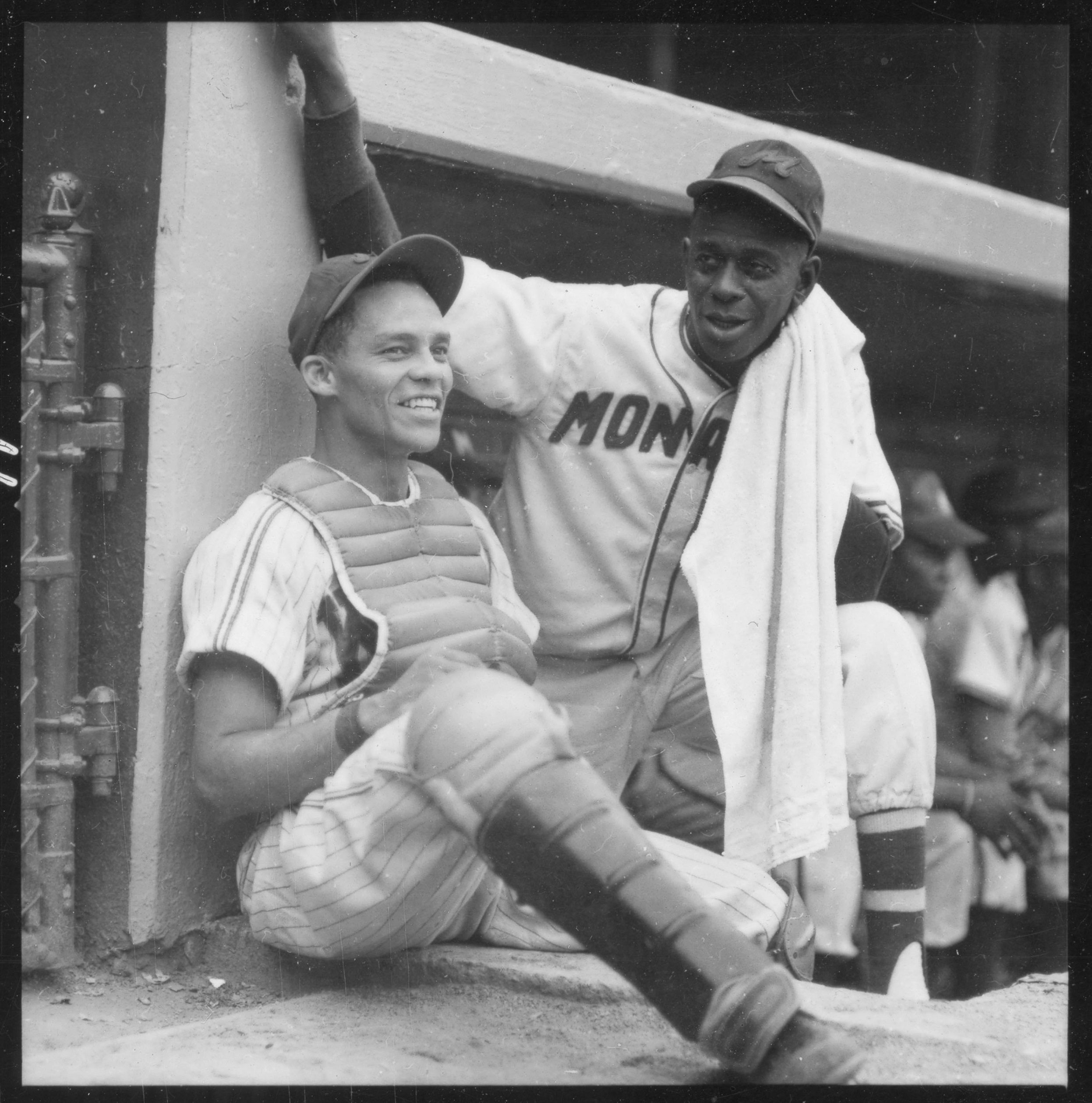
Satchel Paige (right, with towel) talking to unknown catcher, Chicago, August 2, 1955. CHM, ICHi-052257; photograph by Arthur Siegel
Comiskey Park also hosted many of the Negro Leagues’ East-West All-Star contests. In 1933, a group of sports writers developed the idea for an all-star game with fans selecting players via balloting through the popular African American newspapers of the day, such as the Chicago Defender. American Giants players dominated the West squad, taking seven of the nine starting slots. In a back and forth slugfest, the West team won 11 to 7. American Giants pitcher Willie Foster (half-brother of Rube) was the only pitcher in all-star game history to pitch a complete game, pitching all nine innings. American Giants first baseman Mule Suttles had great success at the plate going 2 for 4, scoring two runs while smacking a two bagger and a home run. This all-star game continued at Comiskey Park into the 1950s.

Baseball player Satchel Paige warms up before the East-West Negro American League All-Star Game at Comiskey Park, Chicago, July 31, 1955. Photograph by Mel Larson for the Chicago Sun-Times, ST-17500231, Chicago Sun-Times collection, CHM
With the addition of the Negro Leagues, the MLB now has the monumental task of recalculating statistics, which will change the career numbers for players who got their start in the Negro Leagues, including greats like Satchel Paige, the Cubs’ Ernie Banks, and the White Sox’s Minnie Miñoso. Though gathering Negro League stats will require significant research, the recalculations will ultimately rewrite a more inclusive MLB history.

Christmas tree in the Walnut Room at the Marshall Field’s State Street store, Chicago, December 24, 1959. CHM, ICHi-017139; Clarence W. Hines, photographer
The Marshall Field & Co. department store (now Macy’s) has always gone big for the Christmas holiday, with the annual Great Tree, animated holiday windows, and the forty-two trumpets along State Street. Along with the décor, a visit to their Walnut Room is part of a Chicago holiday tradition.
The Walnut Room is the flagship restaurant of what is now Macy’s in downtown Chicago at State and Washington Streets. The building opened in 1907, and the Walnut Room existed from the start, though it was initially named the South Grill Room. Eventually, the restaurant was renamed for its Circassian walnut paneling, though the exact date of the switch is unclear.
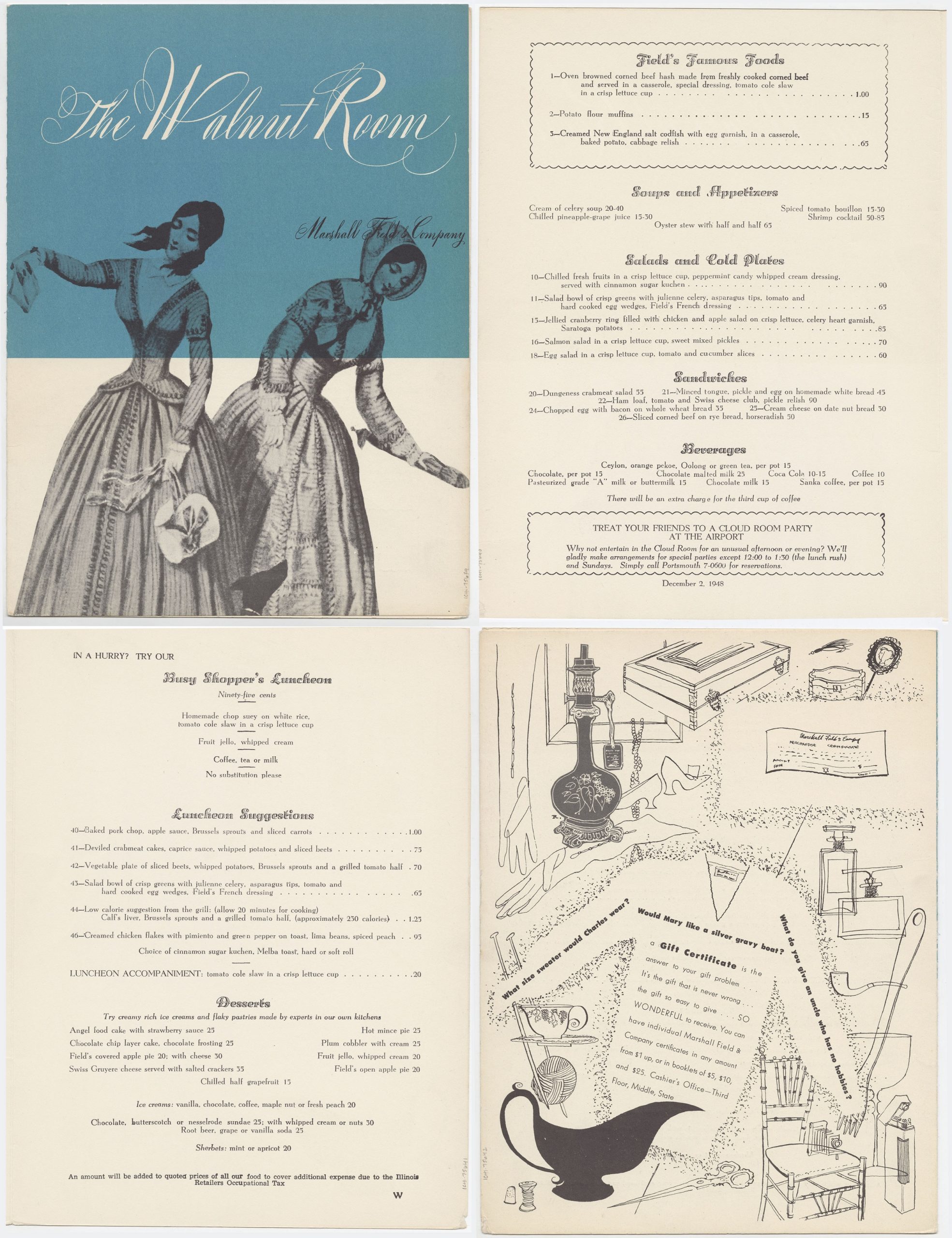
Menu for the Walnut Room at the Marshall Field’s State Street store, Chicago, December 2, 1948. CHM, ICHi-075639, ICHi-075640, ICHi-075641, ICHi-075642; Gift of Target Stores.
For decades, hungry shoppers have enjoyed favorites such as millinery clerk Mrs. Hering’s chicken pot pie, which she started serving in an earlier Field’s restaurant in 1890. At the turn of the twentieth century, restaurants and other leisure spaces in high-end department stores became acceptable places for middle and upper-class white women to spend time outside of the home and meet and dine with friends and family.
Furthermore, department stores served as “respectable” employment for women, giving them an opportunity to become wage earners, though as the opening chapters of Theodore Dreiser’s Sister Carrie point out, employment was still limited to white women with certain clothes and manners. Still, the growing popularity of the Walnut Room and Marshall Field & Co. allowed a degree of economic freedom for certain women and social freedom for others.
The special atmosphere and food have ensured the Walnut Room remains a nostalgic favorite for generations of Chicagoans, especially during the Christmas season.
Trace the city’s evolution from meatpacking capital to foodie paradise through our Google Arts & Culture exhibit Touring Chicago’s Culinary History.
Google Arts & Culture
Google Arts & Culture is an online platform that puts the treasures, stories, and knowledge of more than 2,000 cultural institutions from eighty countries at your fingertips. The Chicago History Museum’s portal includes stories from throughout the city’s history. Peruse the designs of Chicago-born couturier Mainbocher, learn about the work of civil rights leader Reverend J. H. Jackson, and so much more!
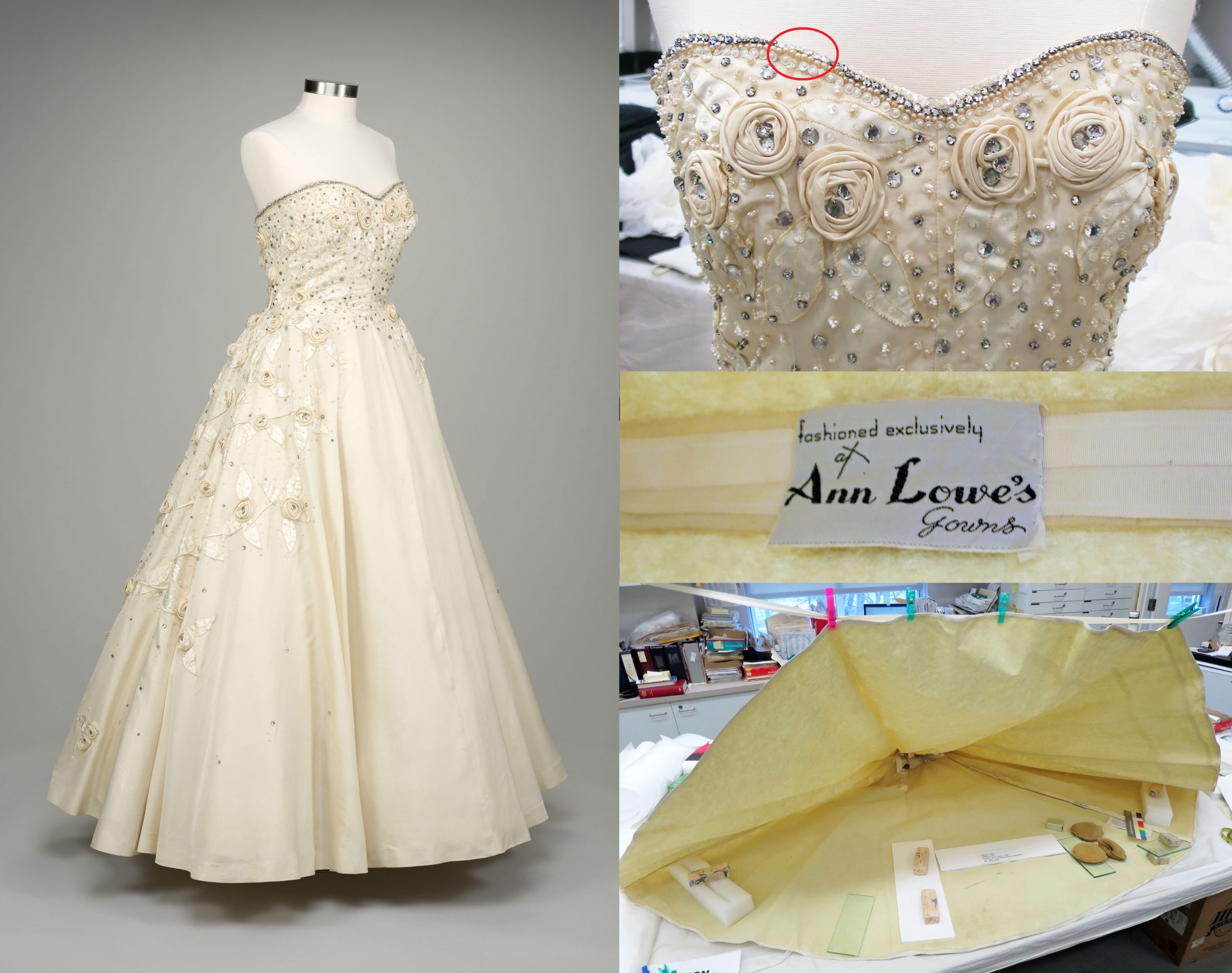
A common museum practice is to loan artifacts to other institutions. This past spring, CHM conservator Holly Lundberg and her team prepared an Ann Lowe cotillion gown (1956) to go on loan to the Peabody Essex Museum (PEM) in Salem, Massachusetts.
Ann Cole Lowe (1898–1981) was an African American fashion designer whose exquisite formal and debutante gowns were sought after by the rich and famous from the 1920s through the 1960s. Lowe is known for her fine handiwork and the use of floral motifs, and though Lowe did not receive credit at the time, she created the iconic wedding gown worn by Jacqueline Bouvier upon her marriage to John F. Kennedy.
The Lowe gown from our costume collection was worn by Carole Duke Denham on December 22, 1956, at the Passavant Cotillion in Chicago. The gown is embellished with fabric appliqués of long-stemmed roses, faux pearls, sequins, glass seed beads, and rhinestones on the bodice and down the sides of the skirt. It has a boned bodice, full skirt, center-back zipper, and an attached underskirt of taffeta lined with a stiff nonwoven material edged with synthetic horsehair at the hem.
After it was requested for loan, the gown was brought to the conservation lab to be assessed for condition, treatment needs, and recommendations for display and handling, as well as for any required conservation treatment. Although heavily wrinkled and creased from long-term storage, the gown was found to be in fairly good condition. The damage that had occurred was largely from normal wear and tear, including some spots and stains, soiling at the hem, and a nine-inch-long tear in the interfacing layer of the underskirt. There were also loose and missing embellishments and partially detached fabric appliqués due in part to aged, brittle embroidery threads and wear.
Over the course of three months, the conservation team painstakingly conserved the dress to resemble its former glory: they secured loose or detaching appliqués, beads, sequins, pearls, and rhinestones; patched the tear in the interlining of the underskirt, and reduced wrinkles and creases throughout. Reshaping of the flattened and crushed flower appliqués was accomplished by hand with the aid of a localized humidification technique whereby a small piece of blotting paper, dampened with deionized water, was carefully wrapped around each flower petal for less than a minute to relax the textile fibers. The flower petals were then gently manipulated back into a bud shape and left to reacclimatize. The Lowe gown is currently on display in PEM’s exhibition Made It: The Women Who Revolutionized Fashion, which is open through March 14, 2021.
See more items in CHM’s renowned costume collection, which includes a pair of Michael Jordan’s shoes, Abraham Lincoln’s top hat, and Bertha Palmer’s gowns.
Clockwise from left: Ann Lowe cotillion gown, 1956. Gift of Mrs. Charles Chaplin, 1976.241.170. CHM, ICHi-175969. Bust of the dress with red circle indicating where rhinestones were replaced. The label of the gown. The setup to repair a tear in the interlining of the underskirt. All images by CHM staff.
Caring for Your Collection
Wondering how to take care of your own beloved garments and textiles? For the winter 2020–21 issue of The Intelligent Collector magazine, CHM collection manager Jessica Pushor spoke to Debbie Carlson for her article “Tending Your Delicates” and describes proper storage methods for various items in our costume collection, such as menswear, silk dresses, sports jerseys, and shoes.